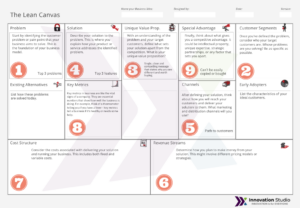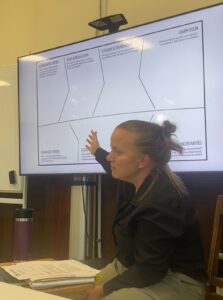Written by: Amy Erickson
During the Innovation Studio CREATE program, you will be introduced to the Lean Canvas business model. The Lean Canvas was developed by Ash Maurya as an adaptation of the Business Model Canvas by Alex Osterwalder. This is a strategic management and startup template aimed to help entrepreneurs quickly define and communicate their business model. This model is ideal for customer discovery, developing a value proposition, and ultimately writing a business plan.
The Lean Canvas highlights key business model aspects in a concise, structured format, emphasizing simplicity and quick iteration. Unlike the business plan, the business model is a living document that adapts and changes as you develop and operate your business. This framework has revolutionized the way startups and businesses conceptualize, validate, and refine their business models. With nine blocks, this canvas provides a structured way for entrepreneurs to analyze ideas, test hypotheses, and adopt a lean, agile mindset. Over the next several weeks, we will dive deeper into each block of the lean canvas, giving examples of what to include and why. Today, we will give an overview of the lean canvas and share ways to view each block.
If you would like to learn more about the Lean Canvas business model, sign up for an upcoming CREATE cohort and we can walk through the model together.

At Innovation Studio, we teach participants to fill out the canvas based on the numerical order of the image above. While it is not essential, doing so can help participants methodically think through their business ideas. This helps them focus on the key aspects: the problem they’ll solve and the customers they’ll serve. Over the next few weeks, our blog will address each of these segments in that order and we encourage you to consider following along.
-
Problem: The first block of the Lean Canvas, “Problem,” serves as the bedrock upon which the entire business model is built. It prompts entrepreneurs to pinpoint a specific pain point or challenge their target customers are facing.
-
Customer Segments: In the “Customer Segments” block, entrepreneurs define the diverse groups of individuals or organizations their product or service aims to serve. Understanding the unique characteristics, needs, and behaviors of these segments enables businesses to tailor their offerings effectively.
-
Unique Value Proposition (UVP): The “Unique Value Proposition” block compels entrepreneurs to articulate the distinct value that their product or service brings to the table. This concise statement highlights why customers should choose their offering over competitors’. Consider a pet grooming salon with a UVP of “Luxurious spa treatments for refreshed, stylish pets.”
-
Solution: The “Solution” block delves into how entrepreneurs plan to address the problem identified earlier. It outlines the core features, benefits, or services that make up the proposed solution.
-
Channels: “Channels” refer to the different methods entrepreneurs use to reach and engage their target customers. This block involves choosing the most effective distribution, communication, and sales channels.
-
Revenue Streams: In the “Revenue Streams” block, entrepreneurs outline how their business will generate income from their customer segments. This involves exploring pricing strategies, monetization models, and potential income sources.
-
Cost Structure: The “Cost Structure” block compels entrepreneurs to analyze the key expenses associated with running their business and delivering their product or service. This includes factors such as production costs, marketing expenses, employee salaries, and overhead.
-
Key Metrics: In the “Key Metrics” block, entrepreneurs are prompted to identify the critical metrics that provide insights into the performance and success of their business. These measurable indicators guide decision-making and strategy adjustments.
-
Unfair Advantage: The final block, “Unfair Advantage,” underscores what sets the business apart from competitors and gives it a distinct edge. This could be specialized expertise, exclusive partnerships, or proprietary technology.

The Lean Canvas business model is an approachable, strategic tool to help you identify your business model and work through the early struggles in establishing your business. At Innovation Studio, our program guides you through filling out the chart, focusing on key points to help you develop your new business. We encourage you to check out our programs and make an appointment for Entrepreneurship Navigation today to join the next CREATE class.

